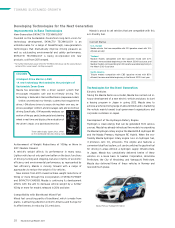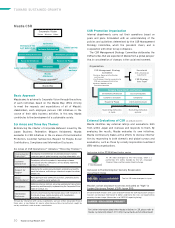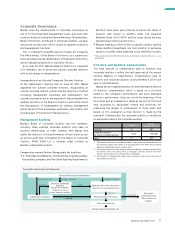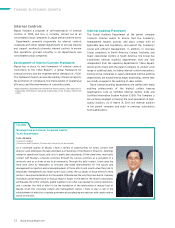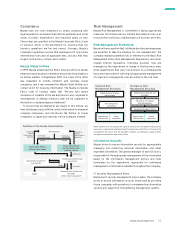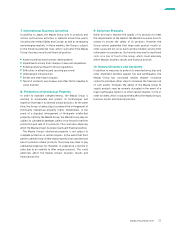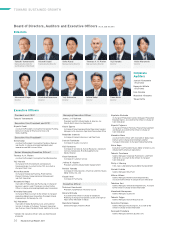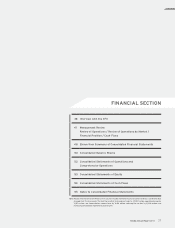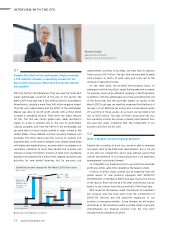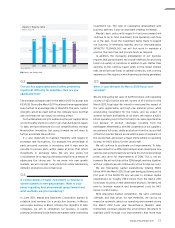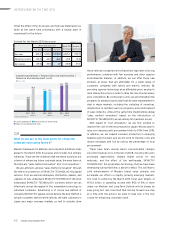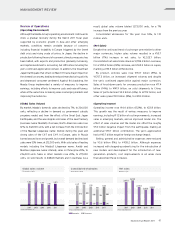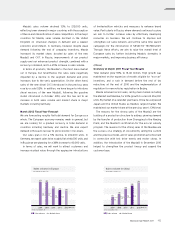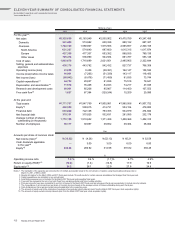Mazda 2011 Annual Report Download - page 40
Download and view the complete annual report
Please find page 40 of the 2011 Mazda annual report below. You can navigate through the pages in the report by either clicking on the pages listed below, or by using the keyword search tool below to find specific information within the annual report.
INTERVIEW WITH THE CFO
Kiyoshi Ozaki
Representative Director
Executive Vice President and CFO
Q1
Despite the effect of the earthquake, Mazda recorded
a ¥14.4 billion increase in operating income for the
March 201 1 fiscal year. What were the factors behind
this growth?
With the further strengthening of the yen and the Great East
Japan Earthquake occurring at the end of the period, the
March 201 1 fiscal year was a very difficult year for automakers.
Nevertheless, despite a more than ¥40 billion negative impact
from the yen’s appreciation and the effect of the earthquake,
Mazda was able to record profit growth with a ¥14.4 billion
increase in operating income. There were two major reasons
for this. The first was strong global sales. Sales declined in
Japan on a fall in demand due to the end of government
subsidy programs and from the effect of the earthquake, but
we were able to record steady growth in sales volume in the
United States, China, ASEAN countries including Thailand, and
Australia. The other reason was the success of ongoing cost
improvements. In the area of variable costs, despite being faced
with higher raw material prices, we were able to accelerate cost
innovation initiatives to more than absorb the increase and
improve costs by ¥1 1.2 billion. In terms of fixed costs, marketing
expenses increased by ¥5.6 billion from stepped-up advertising
activities for new model launches, but by pursuing cost
YoY +14.4 2011
9.5
+35.7
(43.7)
(5.6)
+16.7 23.8
+11.2
2010
Volume & Mix Foreign
exchange
Cost
improvements
Marketing
expenses
Others
Operating income change for the March 2011 fiscal year
Billions of yen
(Years ended March 31)
Includes the
decrease of about
¥5.0 billion due to
the impact of the
earthquake
U.S. dollar (20.7)
Euro (20.7)
Other (2.3)
improvement activities in all areas, we were able to improve
fixed costs by ¥16.7 billion. The fact that we were able to make
solid progress in terms of both sales and costs led to the
increase in operating income.
On the other hand, we recorded extraordinary losses on
damages from the Great East Japan Earthquake and a reserve
for business losses at an affiliated company in North America.
In addition, with the earthquake occurring just before the end
of the fiscal year and the uncertain impact on results in the
March 2012 fiscal year, we carefully examined the likelihood of
recovery of our deferred tax assets, and conservatively wrote
off a portion of those assets. As a result, we recorded a net
loss of ¥60.0 billion. This was our third consecutive net loss,
but operating income has shown a steady improvement over
the past two years, indicating that the momentum of our
business activities did not slow.
Q2
What is Mazda’s current financial position?
Despite the recording of a net loss, we were able to maintain
our equity ratio at the 24% level. Nevertheless, this is not yet
in line with our competitors, and it goes without saying that
further improvement of our financial position is an important
management issue going forward.
To strengthen our financial position, we need to accumulate
profit and at the same time streamline the balance sheet.
In terms of profit, major growth can be expected from the
global launch of new products equipped with SKYACTIV
TECHNOLOGY in the March 2012 fiscal year. Due to the timing
of the launch, there will not be a full-year contribution, but we
expect to see a boost from the second half of the fiscal year.
With regard to the balance sheet, the amount of investment
will increase over the short term from the introduction of
SKYACTIV vehicles and the proactive expansion of our
business in emerging markets. Going forward, we will reduce
inventories to the maximum extent possible, while in principle
strengthening our financial position over the long term
through the accumulation of profit.
Operating income Improve Worsen
38 Mazda Annual Report 201 1


